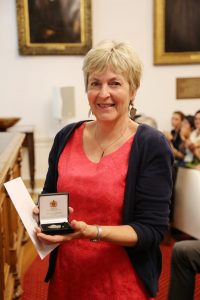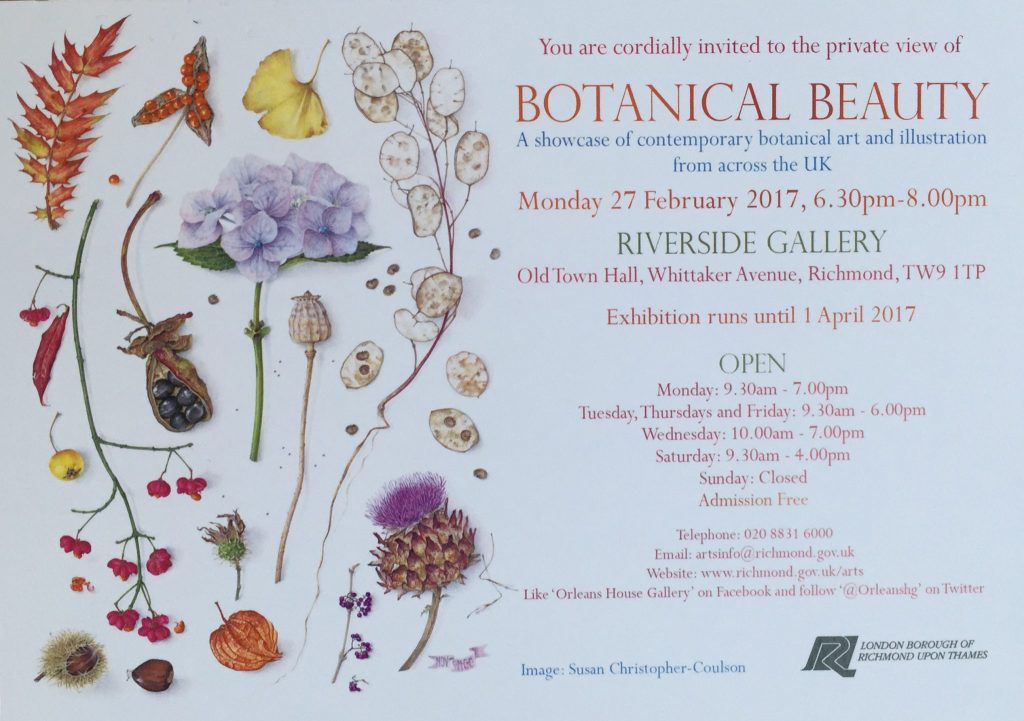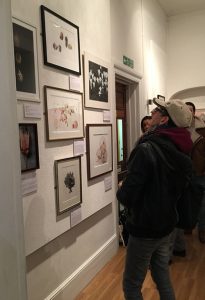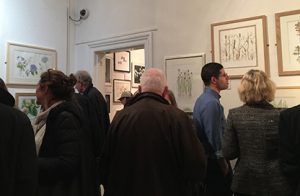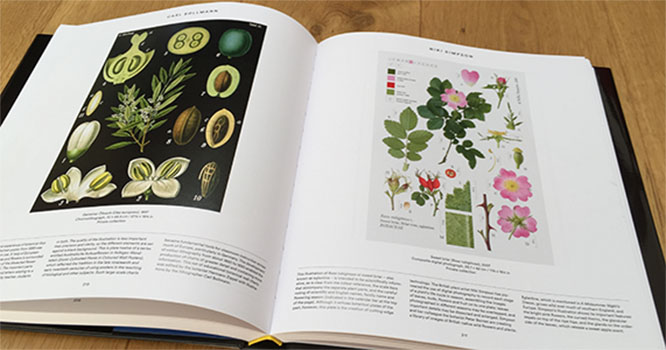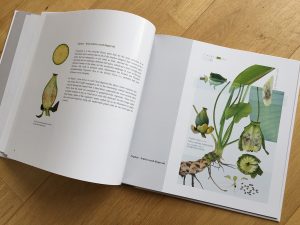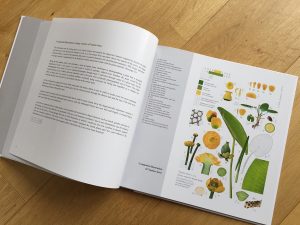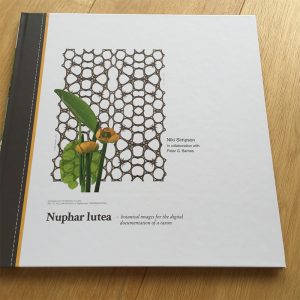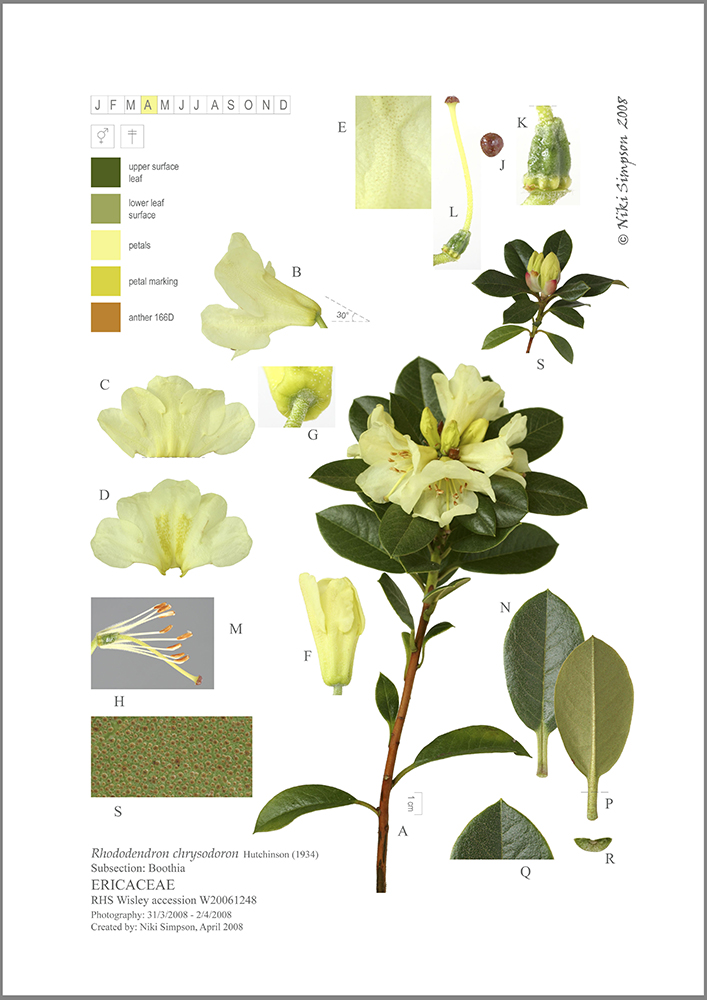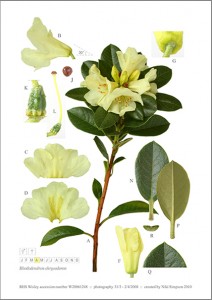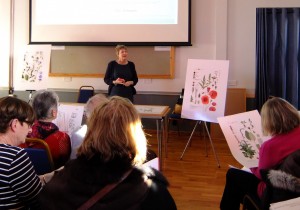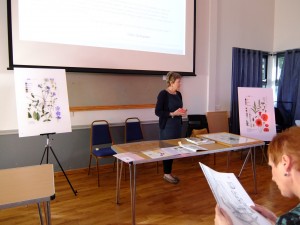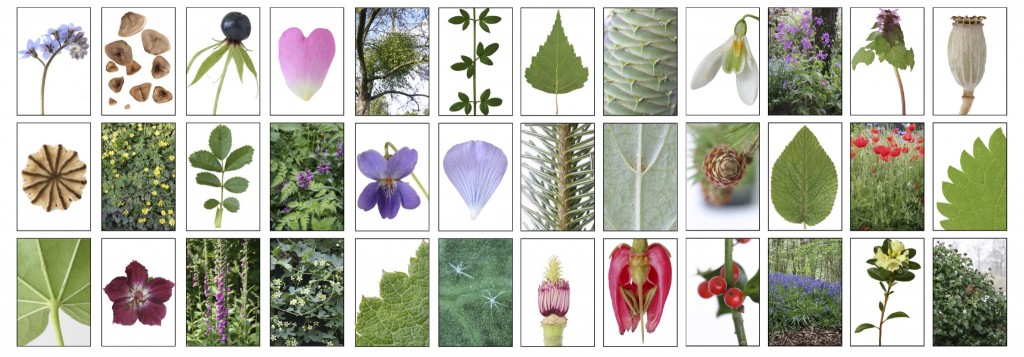The Jill Smythies Award given for digitally created botanical illustrations
It has been a very busy time of year for the botanical art world, both in the UK and around the world, and it has also been a quietly interesting one. I am delighted to write that at the Anniversary Meeting of the Linnean Society of London on May 24th, I received The Jill Smythies Award, given to “a botanical artist in recognition of excellence in published illustrations, such as drawings or paintings, in aid of plant identification, with the emphasis on botanical accuracy and the accurate portrayal of diagnostic characteristics”. Also receiving the award was Juliet Williamson, for her taxonomic illustrations (pen and ink) for Kew, and is known for her black and white illustrations for “The Kew Plant Glossary: An Illustrated Dictionary of Plant Identification Terms”.
While Juliet’s work is traditional, mine is not. My award was given specifically for my digitally created botanical illustrations using photography, and not for my earlier watercolour work. I would like to thank the Linnean Society of London for their open-mindedness in acknowledging the scientific content my digitally created work, at a time when this type of botanical illustration is still not acceptable to many. And I simply must acknowledge the huge contribution made by botanist Peter Barnes to developing my digital illustration technique.
See also Digital botanical illustrations recognized by the Linnean Society of London May 30, 2018 by Art Plantae.
There is another annually given, international, botanical illustration award, the Margaret Flockton Award made by The Royal Botanic Garden Sydney, Australia, which also “focuses on contemporary scientific botanical illustration, as distinct from botanical art”. It is given to an illustrator for “scientifically accurate drawings that accompany the published taxonomic description of the plant, clearly highlighting all of the distinctive features of the species”, but where submissions are restricted to black and white taxonomic illustrations. The results were announced quite recently, with the First Prize going to Natanael Nascimento, from Brazil, for his digital illustration of Lapidia apicifolia. Congratulations to Natanael and the other four! Notably, of the top five entries, not one but two were digital illustrations. Juan Luis Castillo, from Spain, a recipient of the Jill Smythies Award in 2001, is one of the three Highly Commended entries with a digital illustration of Theobroma cacao. Alice Tangerini, while Highly Commended for her traditionally drawn in pen and ink plate of Vernonia echioides, also now illustrates using digital as well as traditional techniques as staff illustrator at the National Museum of Natural History, Smithsonian Institution in the USA. See also “Art, Botany and new technologies” by Juan Luis Castillo.
One could argue then that the making of these awards perhaps signals a degree of acceptance of digital techniques and that we are entering a period of transition for botanical illustration. Personally I feel no need to justify digitally created illustrations in an undeniably digital age (see my blog post from 3 years ago “The digital divide – botanical illustration in an age of change”, Jan 20, 2015) and am happy to let my images speak for themselves – one day I hope in an interactive way so that their potential can be realised.
I know change is difficult, but we are all faced these days with accepting technology in nearly every aspect of our lives. It was my love of plants and my interest in the future of botanical illustration that led me to experiment. Those employed in botanical institutions around the world, such as the Royal Botanic Garden Kew, will surely understand that a photographic technique quite simply and obviously cannot be used to illustrate from dried, flattened herbarium specimens, nor from extinct plant species for that matter. The creative process of compiling a composite botanical plate involves botanical knowledge, working in collaboration with a botanist, direct observation from life, hand-eye skills, accurate measurement, detail and accuracy of form and colour, a heavy emphasis on composition and importantly expertise in the established conventions of botanical art – regardless of whether this end is achieved by digital photography, digital drawing, digitally rendered drawing or by traditional methods
Perhaps 2018 and this year’s awards will prompt further argument against embracing digital techniques, but on the other hand it is always possible that opposition will just fall away, and before long digitally created and digitally rendered entries are considered, if not the norm, at least quite normal.
Botanical Beauty Exhibition
Last night was the Private View for the new Botanical Beauty exhibition opening in the Riverside Gallery in Richmond. There are two rooms packed full of botanical art – nearly all are paintings, but happily mine was not the only digital print. It was good to meet up with other botanical artists and see the variety of botanical art on display.
I was pleased to have a digitally created botanical work included in a botanical art exhibition. My piece, entitled ‘Named by Linnaeus’, contains 16 small images of British wild flowers and trees named by Linnaeus mounted within a dark wood frame.
For anyone wanting to visit the gallery, it’s located in the town centre, near to the bridge, in the Old Town Hall. The gallery website gives details of the opening hours – closed on Sundays, but admission is free. The exhibition runs until 1st April 2017.
Season’s greetings to all
SEASON’S GREETINGS
 If you haven’t found it already, take a look at Advent Botany 2016, which is a Christmas countdown of festive botanical facts. This is the third year it has been compiled, and above is the Christmas banner I made for this year’s version.
If you haven’t found it already, take a look at Advent Botany 2016, which is a Christmas countdown of festive botanical facts. This is the third year it has been compiled, and above is the Christmas banner I made for this year’s version.
Wishing you all health and happiness for 2017.
Plant – exploring the botanical world
Plant – Exploring the Botanical World
New book by Phaidon editors, with an introduction by James Compton
Published by Phaidon, September 2016
Phaidon has just published a beautiful new book entitled ‘Plant: Exploring the Botanical World’. According to the dust jacket, this book includes “over 300 outstanding botanical works of art from throughout history“, so naturally I am absolutely delighted to have my work selected by an international panel of experts for inclusion in it. There is an extraordinary array of stunning images, from ancient stone carvings and manuscripts, through drawings, paintings, etchings, engravings, lithographs and early photographs, to contemporary works of art. Refreshingly, this book “brings together botanical art across all media” as well as throughout history, and it is eye-opening to see the range of techniques that have been, and are being, used to document or portray plants throughout the world.
It is explained that the artworks are arranged, not as is usual by date or by artist, but in contrasting or complementary pairs, to “create thought-provoking juxtapositions“. For example, my digital composite illustration of the sweet briar rose (on page 211) is placed opposite a 19th century German chromolithograph designed as an educational poster, highlighting the fact that they are both composite images containing labeled plant parts and dissections. The latter though was created a hundred and ten years earlier, is set on a black background and was created for educational purposes, whereas my digitally created illustration has a white background and was created as both a record of a particular plant and as a plate for identification purposes, and was designed to be multi-purpose – for reference, education and to be interactive.
“Plant explores the fascinating role of plants in our history and culture …and celebrates the extraordinary beauty and diversity of plants from around the world”

Hardback £39.95 | 300 colour & black and white illustrations | 352 pages | 290 x 250 mm |
ISBN: 9780714871486 www.phaidon.com
New book is published!
Nuphar lutea – new book by Niki Simpson
I am delighted to report that on 25th May 2016 my new book was published!!
Nuphar lutea – botanical images for the digital documentation of a taxon
The ISBN number is: 978-0-9554917-1-9
If you are interested in purchasing a copy or have questions about it please email me – though I hope to make it available directly through Amazon shortly – in fact just as soon as I’ve worked out how to do that! It’s all been quite a steep learning curve…
The book’s large square format (30 x 30 cm) pushes the price up but it does mean that the main plates can be shown at A4 in size, whether they are landscape or portrait in orientation, so the details of the illustrations can be seen. It is a hardback, coffee-table style, book printed on premium matte paper. Here are just two double page spreads from it to give you an idea of what is inside…
As well as the main composite illustration (above right), there are 11 other main plates, which consider aspects such as the vegetative characters and foliage parts. One plate focuses purely on floral structure and I explain how I created a floral diagram for my particular plant, and which is included within the illustration on floral structure, together with a floral formula. In a further plate I consider how best to include DNA sequence data to bring these illustrations up to date in line with current molecular research. In addition to these main plates, there are 12 smaller illustrations.
The book contains a variety of visual narratives and timeline sequences, and also photographs and explanation of the herbarium voucher specimens I made from the plant. Also included is a black and white digital line art illustration followed by a new type of digital hybrid botanical illustration which I explain and demonstrate. All of the main illustrations are fully explained.
So, although it is about, and printed from, my digital illustrations, much of the content may be of interest to botanical painters as well as digital illustrators, and it will be especially relevant to those interested in the future of botanical art and scientific natural history illustration in particular.
Creating a new botanical illustration book!!
I have been quiet on the blogging front for a while, but I have been very busy…
Since January I have been working hard on putting together a new book about scientific botanical illustration and, very excitingly, the proof copy arrived this week! It is to be a beautiful large, square format, coffee-table style book. I will post more about it as soon as it is published, and give details of its ISBN number and availability.
8. Lasting impressions – thoughts on the permanence of record
I am often asked by botanical painters about my view on the permanence of digital work, and in particular, the transience of my botanical plates. I am repeatedly presented with tales of disaster scenarios where hardware and/or software upgrading has led to loss of data or the inability to read data. I am aware that this is often put up, sometimes not so subtly, as a defence for the continuation of traditional botanical painting against a move to digital illustration. But in this day and age, where so many, if not most, transactions are carried out electronically, this seems to me a strange question, since the same people generally seem happy to use mobile phones, internet banking and cloud storage for their photos, etc., which daily communicate their sensitive data which they wouldn’t be at all happy to lose. Yes, data can be lost or corrupted, but any institution or persons concerned about data which they deem to be important, will save work in industry standard formats and migrate those data accordingly. And surely relevant here, if botanical scientists, whose research botanical artists illustrate, are content to work, experiment and communicate electronically, record and archive digitally and then publish their results on websites or by publication in online journals as standard practice, then why should botanical artists creating illustrations be thought of differently? If the scientists are not worried about losing their scientific data, why should botanical illustrators worry about losing their visual data?
To me, all the negativity I receive over digital work being at risk of corruption and deletion, seems to direct attention away from the fact that a painting has no guarantee of permanence either; it’s just that the risks are different. So, to redress the balance, a digital work can be far more secure that conventional work, where there is only one original. A painting’s very uniqueness, in itself, confers considerable risks – it is a single item and one the artist cannot replace with an identical painting. Any one painting can be lost in transit, damaged at home or when on display, damaged by fire or flood in archives, or simply deteriorate over time, and so in that sense any permanence of record, or at least chance of enduring, is generally only achieved by publication in print or by copies – and in this day and age that will most likely be a digital copy. To emphasize my point, an original painting’s longevity will arise from a myriad of external factors, and often those factors will have little to do with the original artist or even their intentions. A digital image, on the other hand, can exist as multiple printed copies on paper and/or multiple electronic copies on the internet, the same as for copies of a painting, but the original digital image files can themselves be replicated and stored in multiple sites on multiple servers around the globe, and an exact image be recreated from the data – and the flexibility of layout remains available too.
It seems to me, that all such discussion on the permanence or otherwise of digital images simply misses the point – their whole point is that they are not unique and can be replicated exactly – and easily. It’s what they can do that is important. Digital scientific illustrations (and not just mine), are not created primarily for hanging on a wall, but precisely for their reproducibility into many copies; for their suitability for sharing via the internet in emails and text messages for discussions with or between botanists, for their use in apps and in national picture library websites, for ready use on electronic image transfer sites used by publishers, etc. They are created as scientific documents specifically designed to illustrate a scientific article, or to convey particular botanical information to the reader (who nowadays is increasingly likely to be a viewer). If botanical artists and illustrators are to fully support botanists in the future, then surely the illustration medium must suit botanists and publishers practices and methods.
7. Re-compositon: flexibility for multi-purpose use
In number 5 of my explanations, I demonstrated one example of the inherent flexibility of these images, by showing one of my ‘standard’ composite portraits simply re-arranged to fit a horizontal format of the same size. If you look back, you can see that both versions contained the same plant parts and that all the parts were shown at the same scale.
Another possibility is to select just some of the parts and used them to construct a smaller sized plate. Fewer parts within an illustration mean that parts can be depicted at a larger scale, and an illustration of the plant may intentionally only need to show a few aspects of the plant in question for the purpose of illustrating an article or flora.
Since each part can be readily and independently moved and/or scaled up or down, the plate can be pretty much endlessly re-composed. In this way numerous alternative layouts are easily possible without resorting to further study of the plant. Illustrations can be created to fit different page sizes or to create illustrations which require a different emphasis or captioning, such as might be required for submission to differing journals to suit their varying house styles. Equally further photographs of the same plant held in the library of images of plant parts, but which were not already contained within the standard portrait, may added to the composition to achieve a different emphasis and hence use of the illustration.
Left hand image: standard plate; Right hand image: re-composed illustration
Both images © Niki Simpson
To show what I mean, I have re-composed my ‘standard’ composite style illustration of a rhododendron (on the left) to a smaller and differently arranged plate on the right – to suit a smaller journal page, for example a ‘Curtis’s Botanical Magazine-style’ illustration. The plate size has been reduced, the overall rectangle proportion altered slightly, certain plant parts have been excluded, alterations have been made to the text components and one part (the flowering branch) has been enlarged relative to the other parts and fill the plate, in order to suit the journal’s style.
This is just one example – many more combinations and variations are possible!
GSBI – Gloucestershire Society for Botanical Illustration
Last week I headed west to meet the members of the Gloucestershire Society for Botanical Illustration, having been invited as Guest Speaker at their AGM meeting. It was held at the splendid Gambier Parry Hall in Highnam, just outside Gloucester – and just along the road from the Nature in Art Gallery at Twigworth, where the GSBI holds its annual GSBI Exhibition (from 1st – 13th March this year).
I found they were a very friendly group, with diverse interests in Botanical art, including botanical photography. There was considerable interest in my digitally created botanical images, judging by the half hour of questions following my presentation, and the wide-ranging nature of those questions. Topics ranged from whether black backgrounds should be allowed in botanical illustration, through the differing types of layering I use, composition of botanical plates, use of standard colour charts for botanical illustration, right through to the best file types of digital image files to use, whether colour calibration is necessary, paper for digital printing and my views on digital media and the future of botanical illustration!
6. Plant parts – building up an image library
Last year I started a series of posts in which I try explain my digital botanical illustrations – to show how they can (and could be) used and demonstrate, to artists and botanists alike, the benefits of using the digital medium. So now it’s for time to get back to where I left off last year!
As my composite illustrations are largely made up of photographic parts, for each plant I study I take literally hundreds of photographs, but only use a small percentage of them in the final plates. I plan in advance which shots I think will be needed for the illustration I’m working on and also I visualize roughly how each part will fit within the overall composition. I take more photos than necessary at the outset, especially when I think the plant part won’t last, or if I only have the one part to work from and so won’t get another chance. I review the photos taken, keeping only the best for my purposes, and I then I clip out or isolate the selected plant parts from their backgrounds, and file as separate additional images.
Although I plan in advance which shots to take, inevitably there are times when I observe something that I wasn’t expecting, when something is absent from what I have read about, when the angle I selected wasn’t good enough to show a particular feature or even simply when the resulting part doesn’t fit well in the space in the emerging composition. When that is the case, I go back and take yet more photographs. I have just done a rough count, and out of the thousands of photos taken, for my final plates I have used anywhere from 12 in each of my early illustrations, up to 36 in some of my latest ones.
So one of the benefits, for both the botanist and artist, is the considerable collection of pictures that I have built up of the plants I have studied. From this bank of photos all sorts of other images can be readily created of the same taxa at a later date. My collection contains the original photos as well as the ‘cut out’ or isolated versions which I use to make up the final illustrations. The matrix of images above will give you an idea of the range of photographs I take of each plant I study. As you can see, these range from close-up macro shots of diagnostic details to a plant’s habit, and where I can I like to record the plant’s habitat as well, to complete my record of the plant studied. These are available for reproduction.

